Attached files
| file | filename |
|---|---|
| EX-99.1 - EX-99.1 - IDEAYA Biosciences, Inc. | idya-ex991_205.htm |
| 8-K - 8-K - IDEAYA Biosciences, Inc. | idya-8k_20200615.htm |
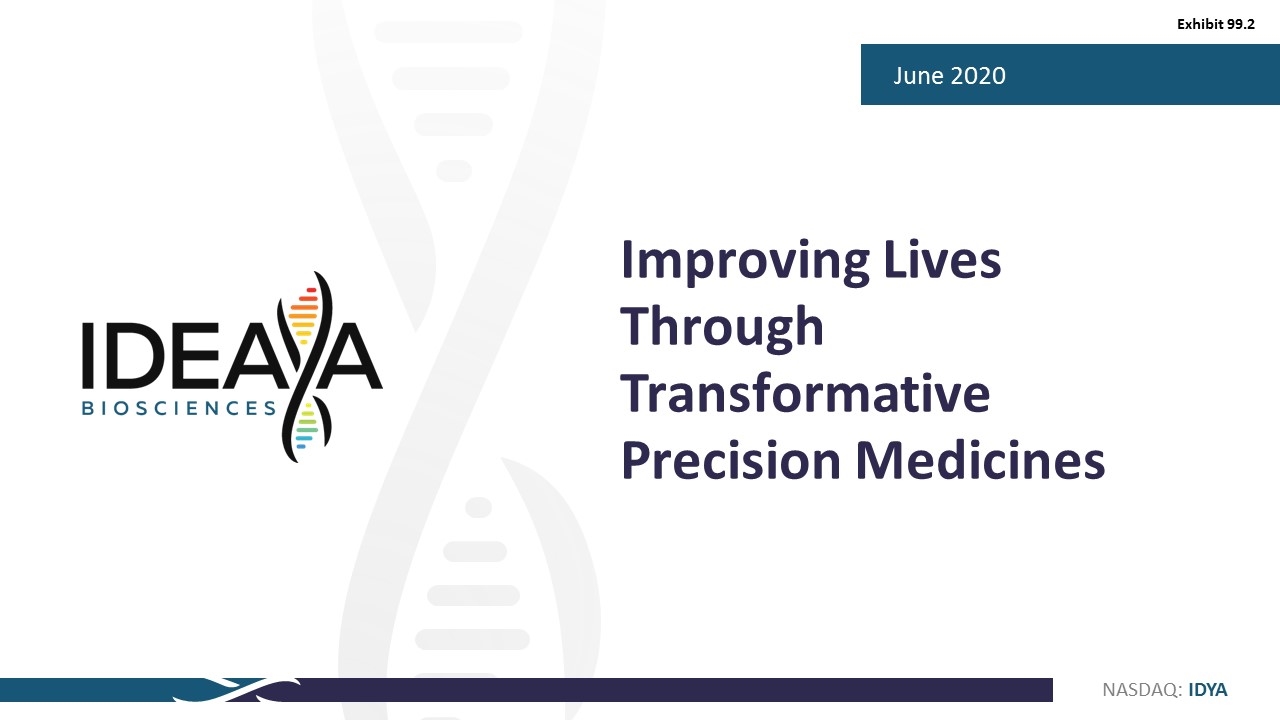
Improving Lives Through Transformative Precision Medicines June 2020 Exhibit 99.2 Ideaya Biosciences Nasdaq: IDYA
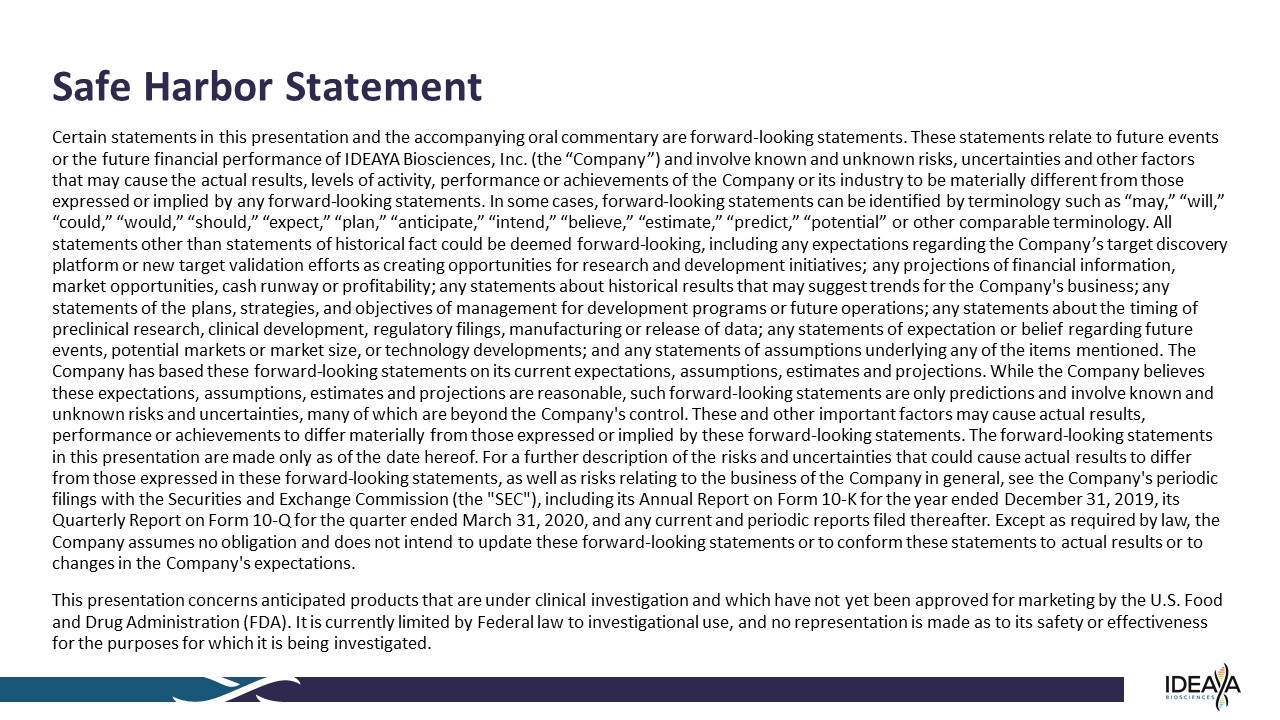
Certain statements in this presentation and the accompanying oral commentary are forward-looking statements. These statements relate to future events or the future financial performance of IDEAYA Biosciences, Inc. (the “Company”) and involve known and unknown risks, uncertainties and other factors that may cause the actual results, levels of activity, performance or achievements of the Company or its industry to be materially different from those expressed or implied by any forward-looking statements. In some cases, forward-looking statements can be identified by terminology such as “may,” “will,” “could,” “would,” “should,” “expect,” “plan,” “anticipate,” “intend,” “believe,” “estimate,” “predict,” “potential” or other comparable terminology. All statements other than statements of historical fact could be deemed forward-looking, including any expectations regarding the Company’s target discovery platform or new target validation efforts as creating opportunities for research and development initiatives; any projections of financial information, market opportunities, cash runway or profitability; any statements about historical results that may suggest trends for the Company's business; any statements of the plans, strategies, and objectives of management for development programs or future operations; any statements about the timing of preclinical research, clinical development, regulatory filings, manufacturing or release of data; any statements of expectation or belief regarding future events, potential markets or market size, or technology developments; and any statements of assumptions underlying any of the items mentioned. The Company has based these forward-looking statements on its current expectations, assumptions, estimates and projections. While the Company believes these expectations, assumptions, estimates and projections are reasonable, such forward-looking statements are only predictions and involve known and unknown risks and uncertainties, many of which are beyond the Company's control. These and other important factors may cause actual results, performance or achievements to differ materially from those expressed or implied by these forward-looking statements. The forward-looking statements in this presentation are made only as of the date hereof. For a further description of the risks and uncertainties that could cause actual results to differ from those expressed in these forward-looking statements, as well as risks relating to the business of the Company in general, see the Company's periodic filings with the Securities and Exchange Commission (the "SEC"), including its Annual Report on Form 10-K for the year ended December 31, 2019, its Quarterly Report on Form 10-Q for the quarter ended March 31, 2020, and any current and periodic reports filed thereafter. Except as required by law, the Company assumes no obligation and does not intend to update these forward-looking statements or to conform these statements to actual results or to changes in the Company's expectations. This presentation concerns anticipated products that are under clinical investigation and which have not yet been approved for marketing by the U.S. Food and Drug Administration (FDA). It is currently limited by Federal law to investigational use, and no representation is made as to its safety or effectiveness for the purposes for which it is being investigated. Safe Harbor Statement
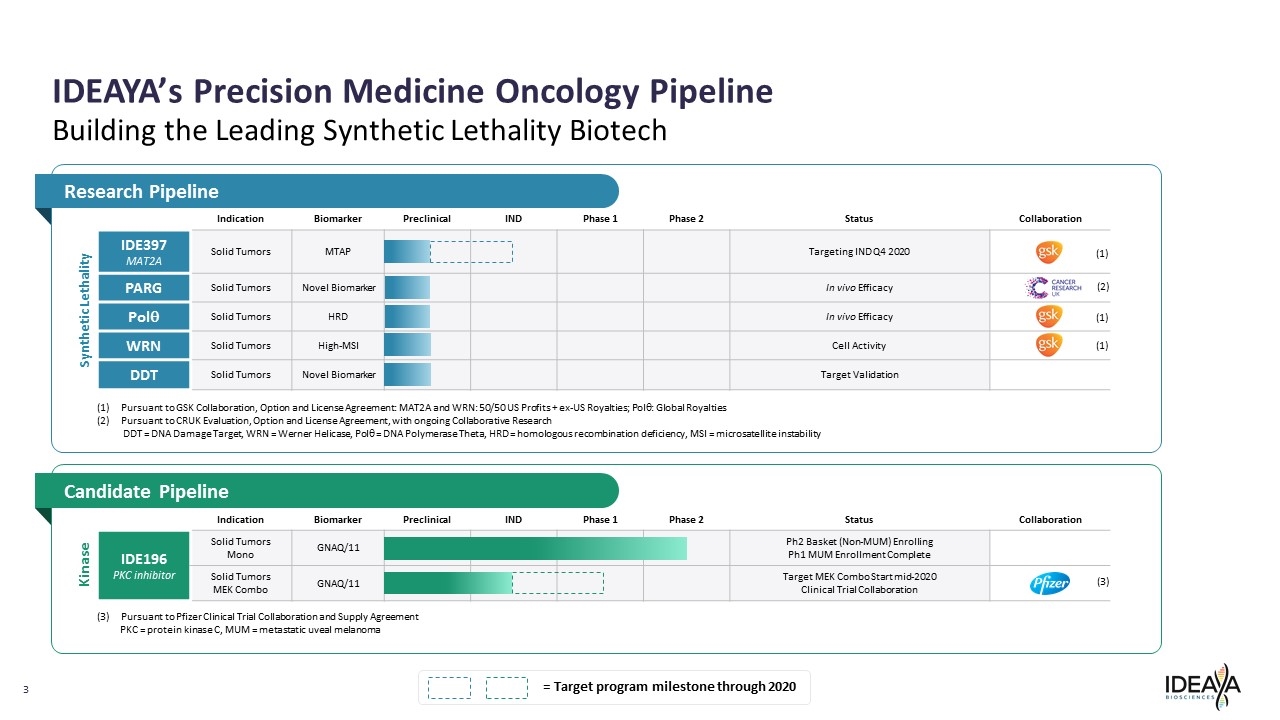
Indication Biomarker Preclinical IND Phase 1 Phase 2 Status Collaboration IDE397 MAT2A Solid Tumors MTAP Targeting IND Q4 2020 PARG Solid Tumors Novel Biomarker In vivo Efficacy Polq Solid Tumors HRD In vivo Efficacy WRN Solid Tumors High-MSI Cell Activity DDT Solid Tumors Novel Biomarker Target Validation IDEAYA’s Precision Medicine Oncology Pipeline Building the Leading Synthetic Lethality Biotech Indication Biomarker Preclinical IND Phase 1 Phase 2 Status Collaboration IDE196 PKC inhibitor Solid Tumors Mono GNAQ/11 Ph2 Basket (Non-MUM) Enrolling Ph1 MUM Enrollment Complete Solid Tumors MEK Combo GNAQ/11 Target MEK Combo Start mid-2020 Clinical Trial Collaboration Kinase Pursuant to Pfizer Clinical Trial Collaboration and Supply Agreement PKC = protein kinase C, MUM = metastatic uveal melanoma Candidate Pipeline Research Pipeline Synthetic Lethality = Target program milestone through 2020 Pursuant to GSK Collaboration, Option and License Agreement: MAT2A and WRN: 50/50 US Profits + ex-US Royalties; Polq: Global Royalties Pursuant to CRUK Evaluation, Option and License Agreement, with ongoing Collaborative Research DDT = DNA Damage Target, WRN = Werner Helicase, Polq = DNA Polymerase Theta, HRD = homologous recombination deficiency, MSI = microsatellite instability (1) (1) (1) (2) (3) [LOGO]
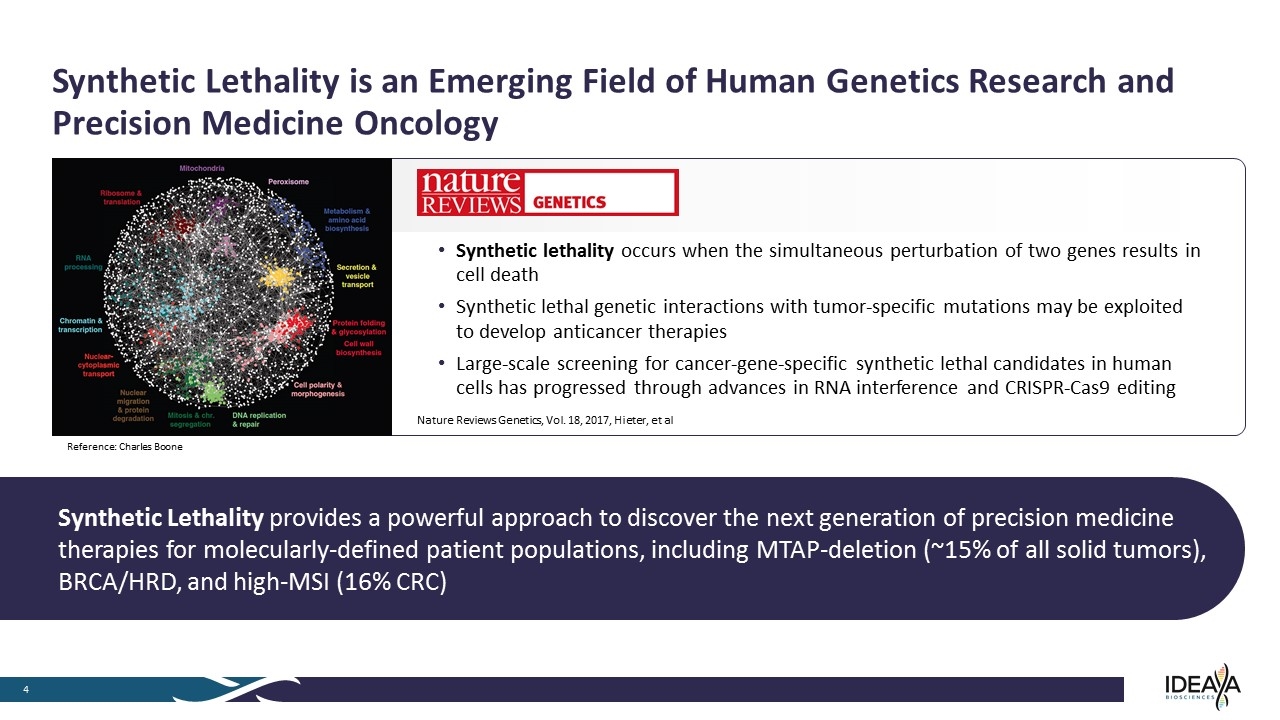
Synthetic Lethality is an Emerging Field of Human Genetics Research and Precision Medicine Oncology Synthetic lethality occurs when the simultaneous perturbation of two genes results in cell death Synthetic lethal genetic interactions with tumor-specific mutations may be exploited to develop anticancer therapies Large-scale screening for cancer-gene-specific synthetic lethal candidates in human cells has progressed through advances in RNA interference and CRISPR-Cas9 editing Synthetic Lethality provides a powerful approach to discover the next generation of precision medicine therapies for molecularly-defined patient populations, including MTAP-deletion (~15% of all solid tumors), BRCA/HRD, and high-MSI (16% CRC) Reference: Charles Boone Nature Reviews Genetics, Vol. 18, 2017, Hieter, et al Mitochondria peroxisome metabolism & amino acid biosynthesis secretion & vesicle transport protein folding& glycosylation cell wall biosynthesis cell polarity & morphogenesis DNA replication & repair mitosis & segregation nuclear migration & protein degradation nuclear-cytoplasmic transport chromatin * transcription rna processing ribosome & translation nature reviews genetics
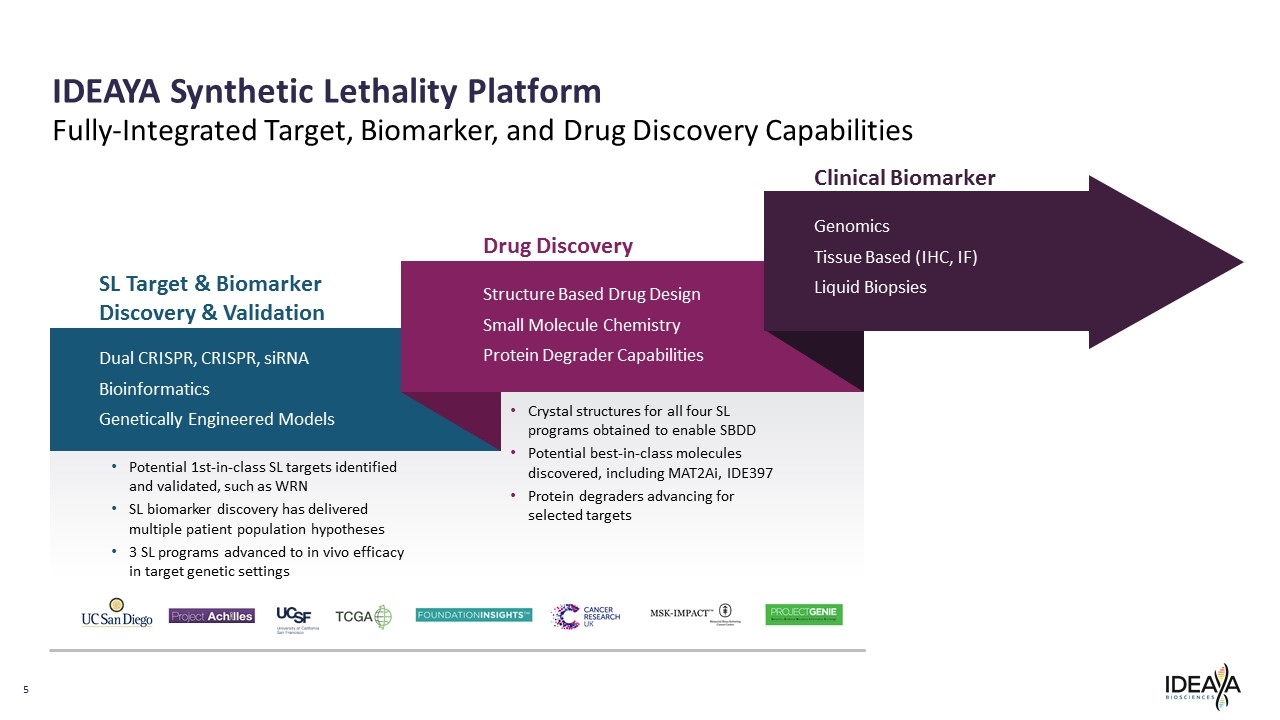
Fully-Integrated Target, Biomarker, and Drug Discovery Capabilities SL Target & Biomarker Discovery & Validation Dual CRISPR, CRISPR, siRNA Bioinformatics Genetically Engineered Models Drug Discovery Structure Based Drug Design Small Molecule Chemistry Protein Degrader Capabilities Potential 1st-in-class SL targets identified and validated, such as WRN SL biomarker discovery has delivered multiple patient population hypotheses 3 SL programs advanced to in vivo efficacy in target genetic settings Crystal structures for all four SL programs obtained to enable SBDD Potential best-in-class molecules discovered, including MAT2Ai, IDE397 Protein degraders advancing for selected targets Clinical Biomarker Genomics Tissue Based (IHC, IF) Liquid Biopsies IDEAYA Synthetic Lethality Platform [COMPANY LOGO]
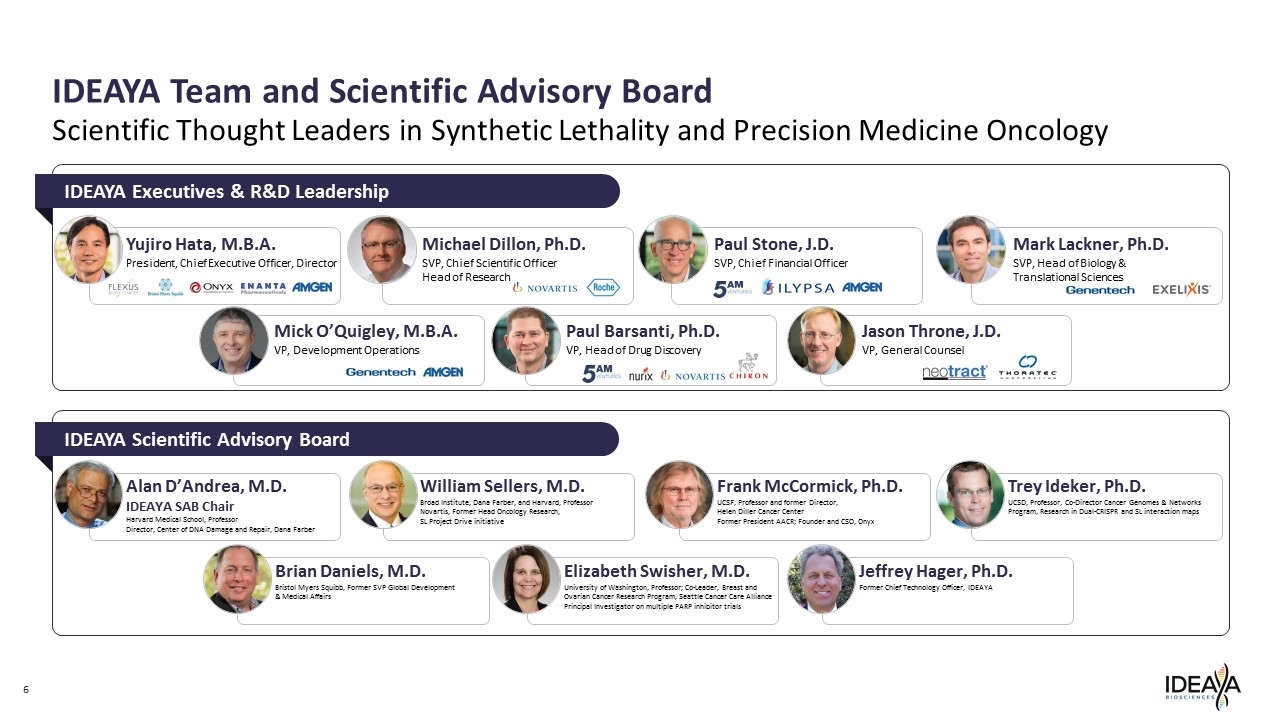
IDEAYA Team and Scientific Advisory Board Scientific Thought Leaders in Synthetic Lethality and Precision Medicine Oncology IDEAYA Executives & R&D Leadership IDEAYA Scientific Advisory Board Yujiro Hata, M.B.A. President, Chief Executive Officer, Director Paul Stone, J.D. SVP, Chief Financial Officer Michael Dillon, Ph.D. SVP, Chief Scientific Officer Head of Research Mark Lackner, Ph.D. SVP, Head of Biology & Translational Sciences Mick O’Quigley, M.B.A. VP, Development Operations Paul Barsanti, Ph.D. VP, Head of Drug Discovery Jason Throne, J.D. VP, General Counsel Alan D’Andrea, M.D. IDEAYA SAB Chair Harvard Medical School, Professor Director, Center of DNA Damage and Repair, Dana Farber William Sellers, M.D. Broad Institute, Dana Farber, and Harvard, Professor Novartis, Former Head Oncology Research, SL Project Drive initiative Frank McCormick, Ph.D. UCSF, Professor and former Director, Helen Diller Cancer Center Former President AACR; Founder and CSO, Onyx Trey Ideker, Ph.D. UCSD, Professor, Co-Director Cancer Genomes & Networks Program, Research in Dual-CRISPR and SL interaction maps Jeffrey Hager, Ph.D. Former Chief Technology Officer, IDEAYA Elizabeth Swisher, M.D. University of Washington, Professor; Co-Leader, Breast and Ovarian Cancer Research Program, Seattle Cancer Care Alliance Principal Investigator on multiple PARP inhibitor trials Brian Daniels, M.D. Bristol Myers Squibb, Former SVP Global Development & Medical Affairs [COMPANY LOGO]
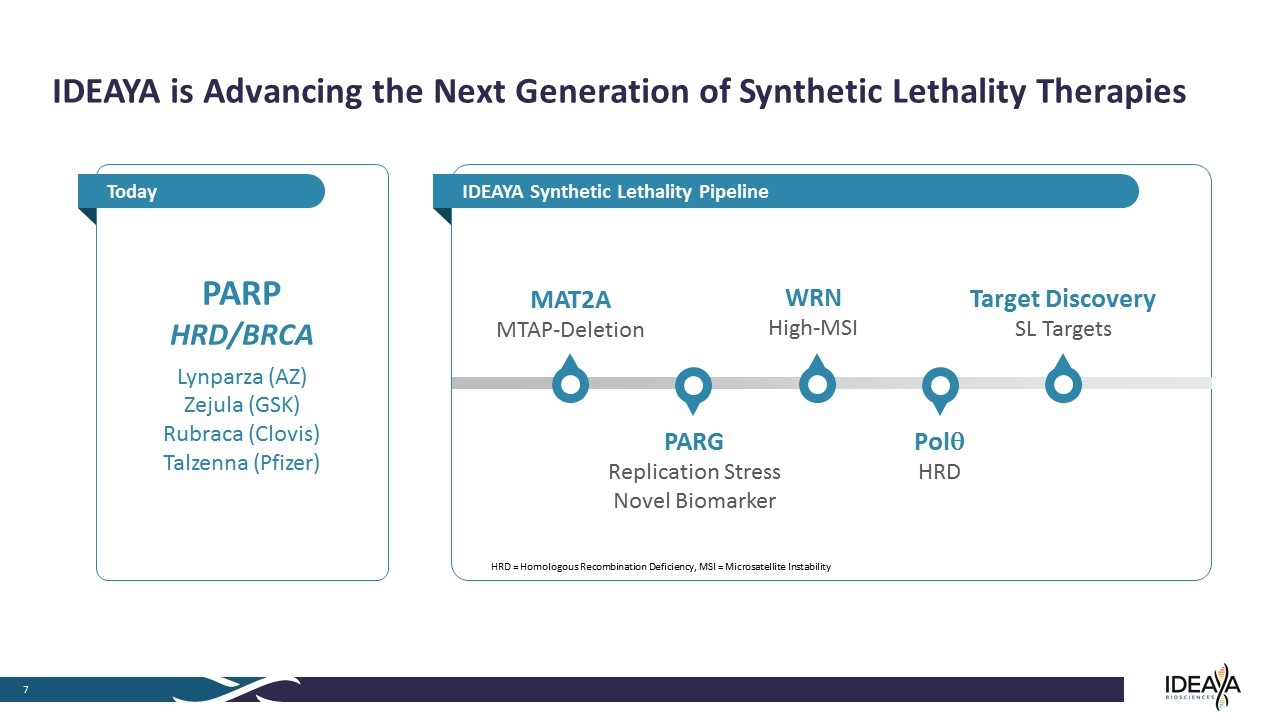
IDEAYA is Advancing the Next Generation of Synthetic Lethality Therapies PARP HRD/BRCA Lynparza (AZ) Zejula (GSK) Rubraca (Clovis) Talzenna (Pfizer) Today IDEAYA Synthetic Lethality Pipeline MAT2A MTAP-Deletion WRN High-MSI Target Discovery SL Targets Polq HRD PARG Replication Stress Novel Biomarker HRD = Homologous Recombination Deficiency, MSI = Microsatellite Instability
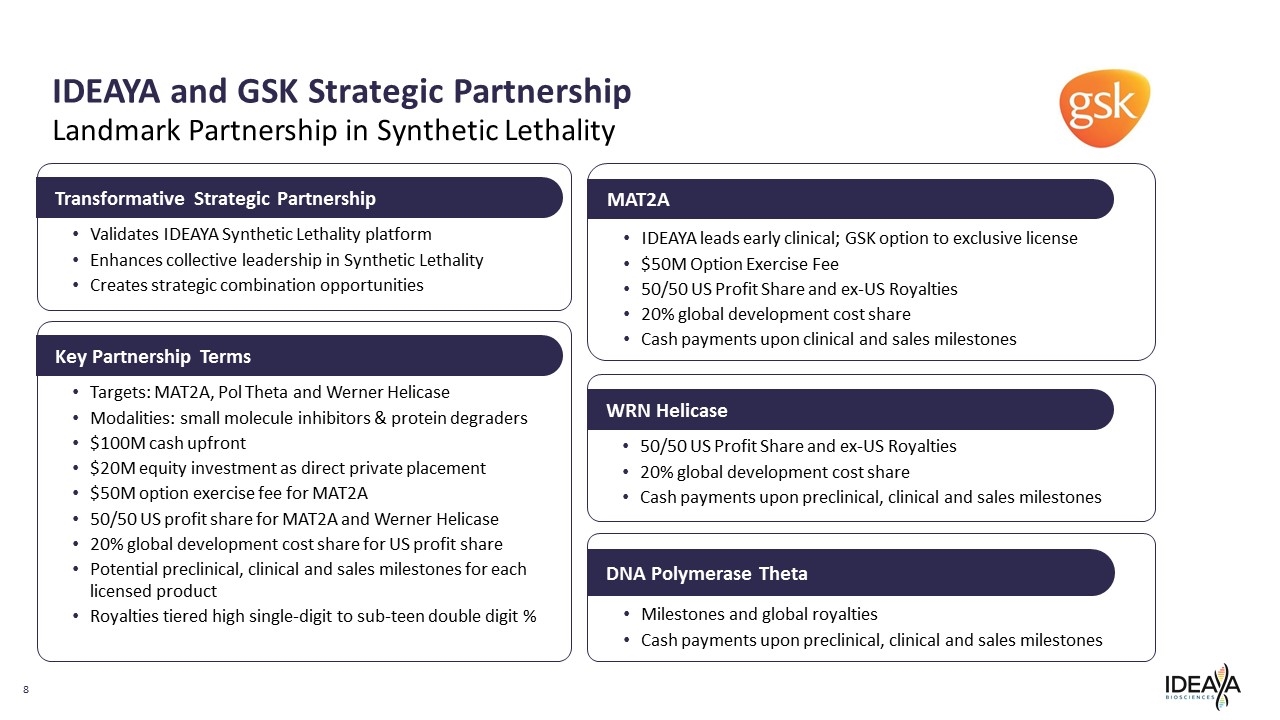
IDEAYA and GSK Strategic Partnership Landmark Partnership in Synthetic Lethality Validates IDEAYA Synthetic Lethality platform Enhances collective leadership in Synthetic Lethality Creates strategic combination opportunities Transformative Strategic Partnership Targets: MAT2A, Pol Theta and Werner Helicase Modalities: small molecule inhibitors & protein degraders $100M cash upfront $20M equity investment as direct private placement $50M option exercise fee for MAT2A 50/50 US profit share for MAT2A and Werner Helicase 20% global development cost share for US profit share Potential preclinical, clinical and sales milestones for each licensed product Royalties tiered high single-digit to sub-teen double digit % Key Partnership Terms DNA Polymerase Theta 50/50 US Profit Share and ex-US Royalties 20% global development cost share Cash payments upon preclinical, clinical and sales milestones WRN Helicase MAT2A Milestones and global royalties Cash payments upon preclinical, clinical and sales milestones IDEAYA leads early clinical; GSK option to exclusive license $50M Option Exercise Fee 50/50 US Profit Share and ex-US Royalties 20% global development cost share Cash payments upon clinical and sales milestones [COMPANY LOGO]
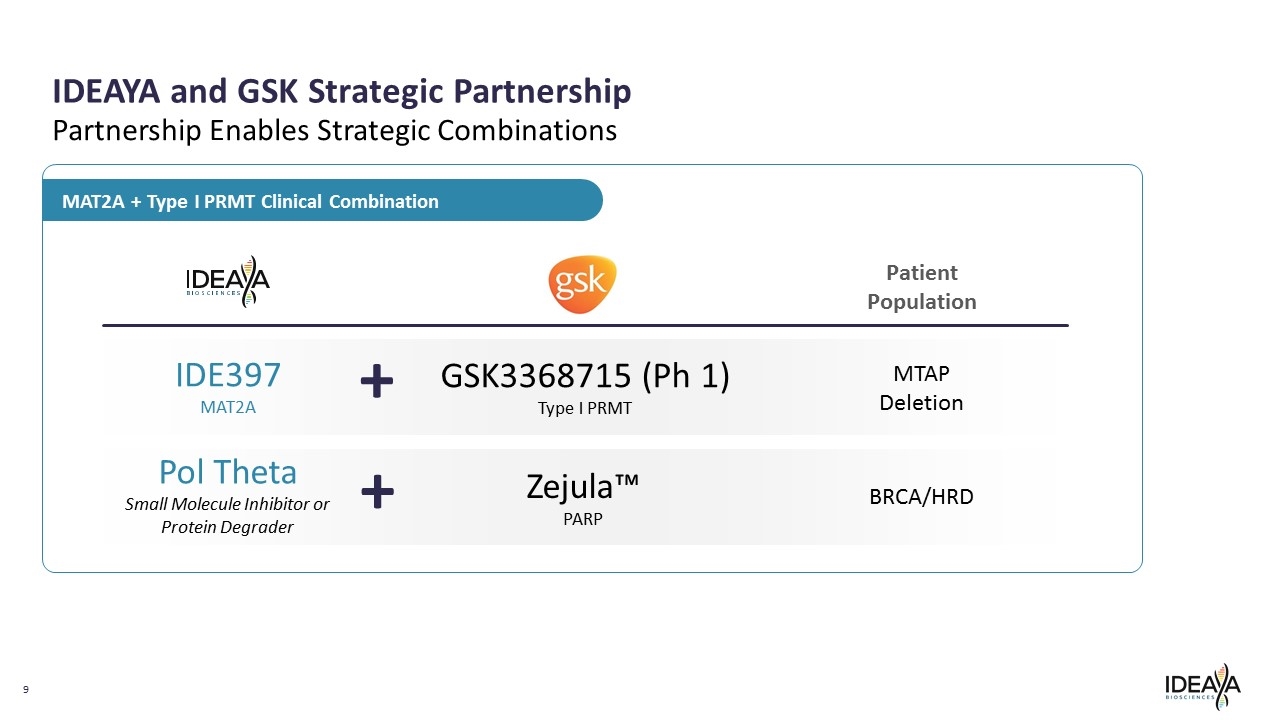
IDEAYA and GSK Strategic Partnership Partnership Enables Strategic Combinations IDE397 MAT2A GSK3368715 (Ph 1) Type I PRMT + Pol Theta Small Molecule Inhibitor or Protein Degrader Zejula™ PARP + Patient Population MTAP Deletion BRCA/HRD MAT2A + Type I PRMT Clinical Combination [COMPANY LOGO]
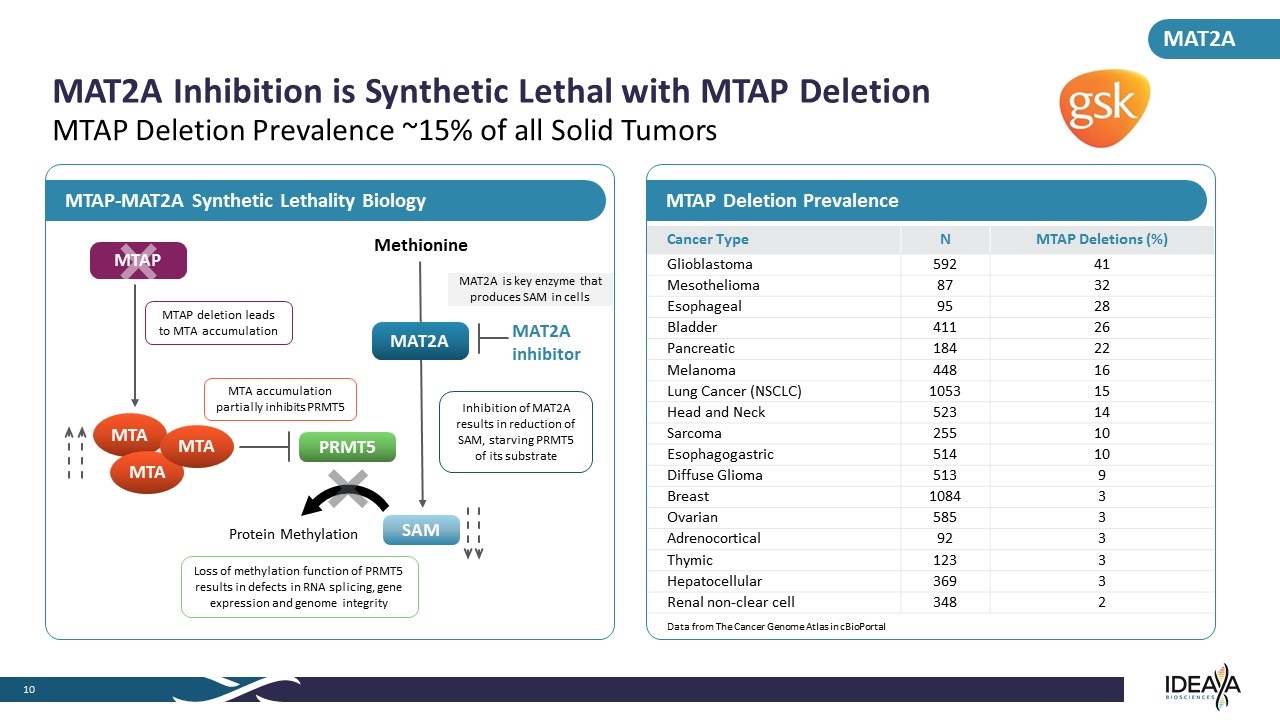
MTAP Deletion Prevalence MTAP-MAT2A Synthetic Lethality Biology MAT2A Inhibition is Synthetic Lethal with MTAP Deletion MTAP Deletion Prevalence ~15% of all Solid Tumors Data from The Cancer Genome Atlas in cBioPortal Cancer Type N MTAP Deletions (%) Glioblastoma 592 41 Mesothelioma 87 32 Esophageal 95 28 Bladder 411 26 Pancreatic 184 22 Melanoma 448 16 Lung Cancer (NSCLC) 1053 15 Head and Neck 523 14 Sarcoma 255 10 Esophagogastric 514 10 Diffuse Glioma 513 9 Breast 1084 3 Ovarian 585 3 Adrenocortical 92 3 Thymic 123 3 Hepatocellular 369 3 Renal non-clear cell 348 2 MAT2A MAT2A inhibitor MAT2A Methionine MAT2A is key enzyme that produces SAM in cells SAM PRMT5 MTAP Protein Methylation MTA MTA MTA MTAP deletion leads to MTA accumulation MTA accumulation partially inhibits PRMT5 Loss of methylation function of PRMT5 results in defects in RNA splicing, gene expression and genome integrity Inhibition of MAT2A results in reduction of SAM, starving PRMT5 of its substrate [COMPANY LOGO]
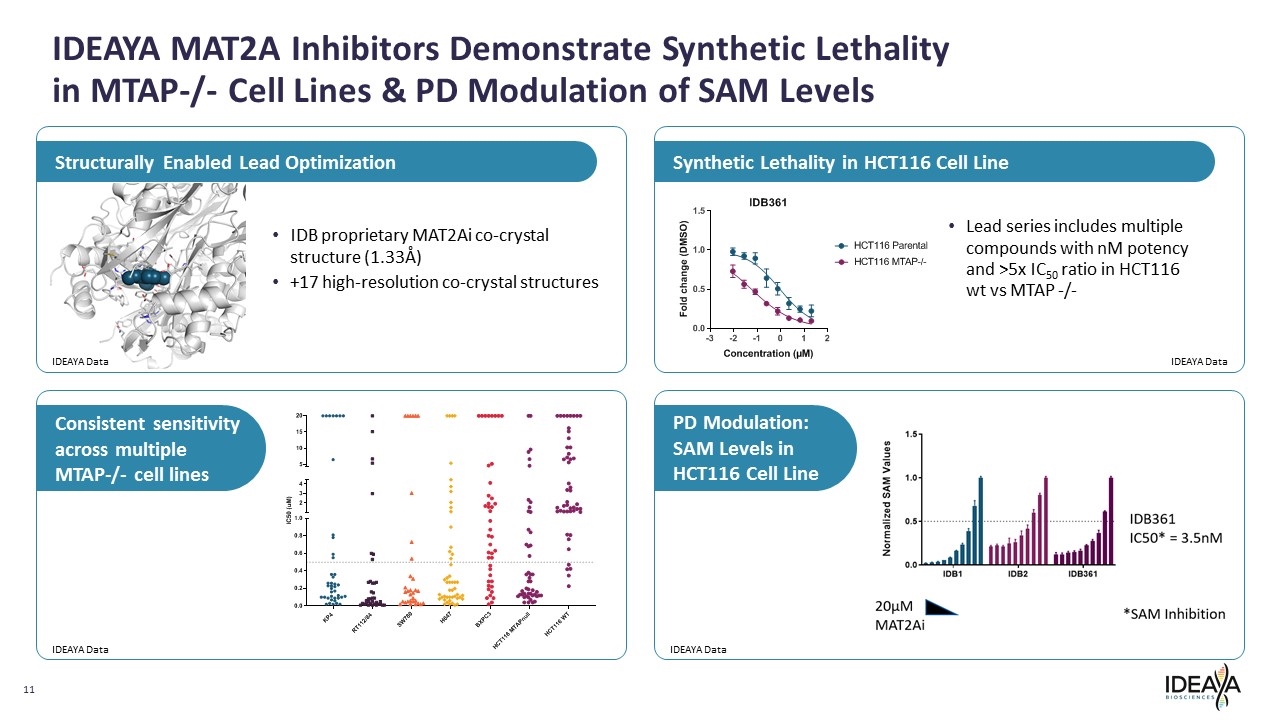
IDEAYA MAT2A Inhibitors Demonstrate Synthetic Lethality in MTAP-/- Cell Lines & PD Modulation of SAM Levels Structurally Enabled Lead Optimization Lead series includes multiple compounds with nM potency and >5x IC50 ratio in HCT116 wt vs MTAP -/- Synthetic Lethality in HCT116 Cell Line Consistent sensitivity across multiple MTAP-/- cell lines PD Modulation: SAM Levels in HCT116 Cell Line IDEAYA Data IDEAYA Data IDEAYA Data IDEAYA Data IDB proprietary MAT2Ai co-crystal structure (1.33Å) +17 high-resolution co-crystal structures [BAR CHART]
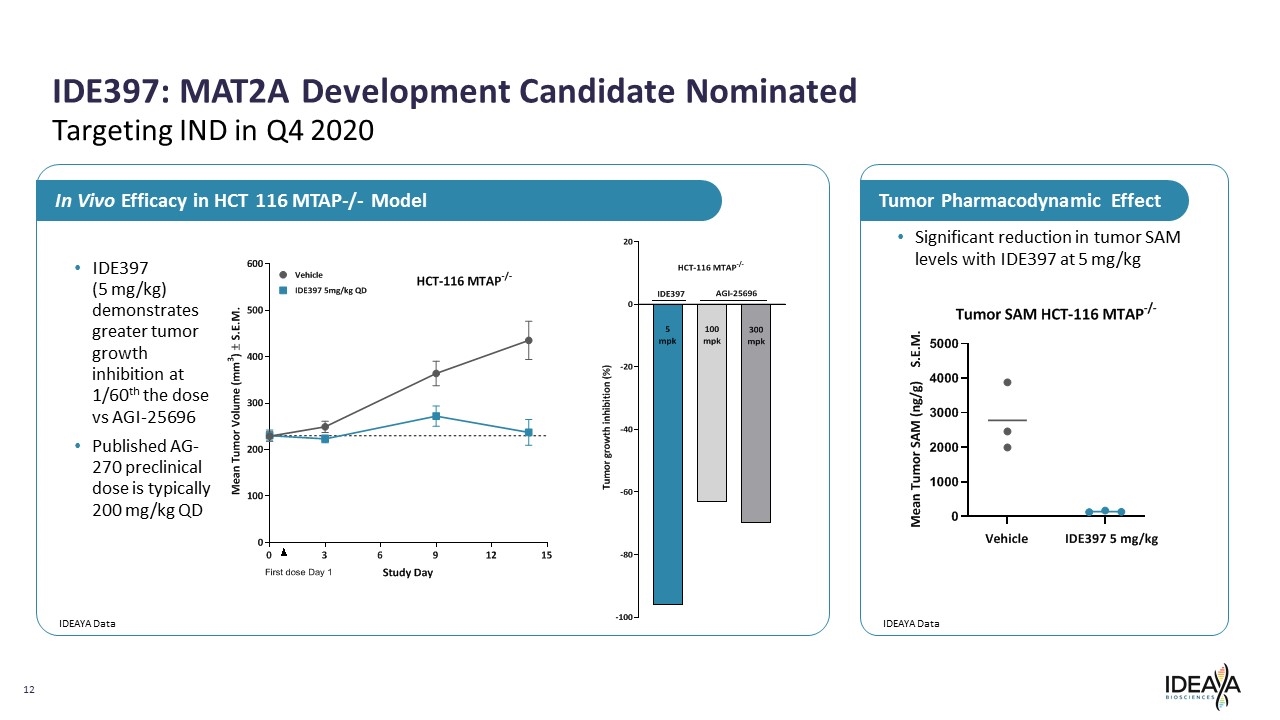
IDE397: MAT2A Development Candidate Nominated Targeting IND in Q4 2020 Significant reduction in tumor SAM levels with IDE397 at 5 mg/kg Tumor Pharmacodynamic Effect IDE397 (5 mg/kg) demonstrates greater tumor growth inhibition at 1/60th the dose vs AGI-25696 Published AG-270 preclinical dose is typically 200 mg/kg QD In Vivo Efficacy in HCT 116 MTAP-/- Model IDEAYA Data IDEAYA Data [BAR CHART]
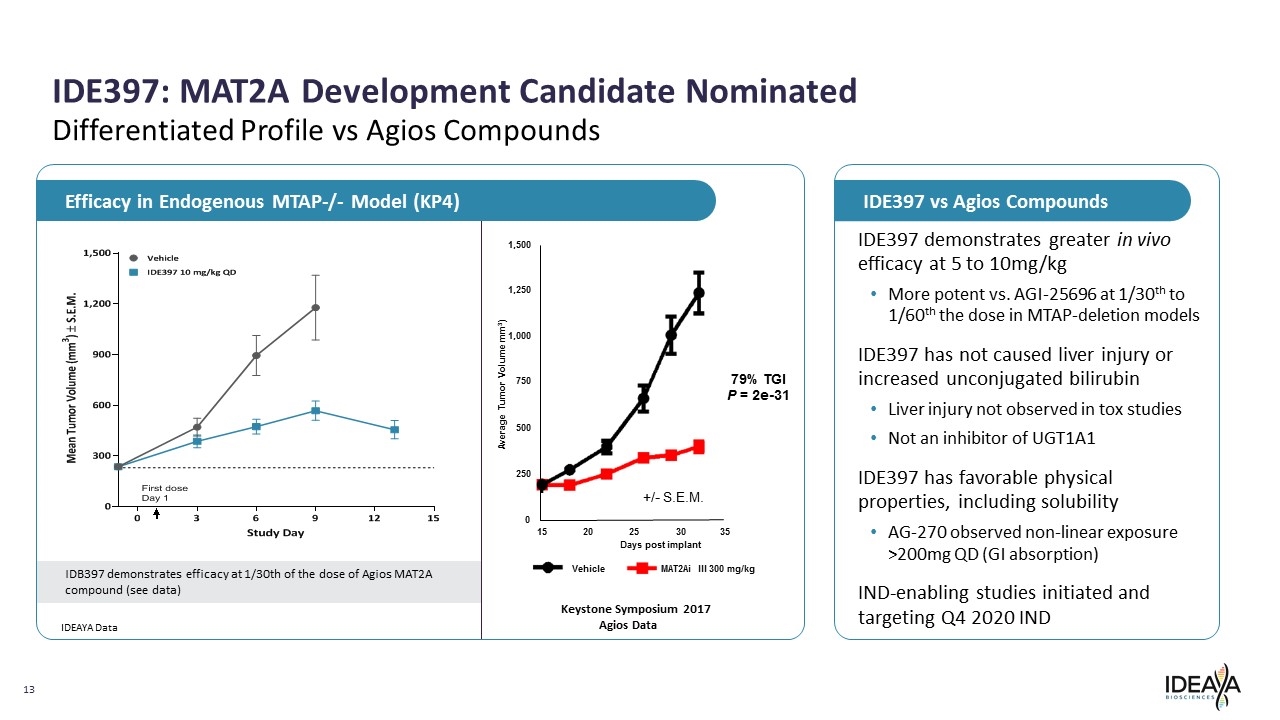
IDB397 demonstrates efficacy at 1/30th of the dose of Agios MAT2A compound (see data) IDE397: MAT2A Development Candidate Nominated Differentiated Profile vs Agios Compounds IDEAYA Data Keystone Symposium 2017 Agios Data Days post implant 15 20 25 30 35 0 250 500 750 1,000 1,250 1,500 +/- S.E.M. 79% TGI P = 2e-31 Average Tumor Volume mm3) Vehicle MAT2Ai III 300 mg/kg IDE397 demonstrates greater in vivo efficacy at 5 to 10mg/kg More potent vs. AGI-25696 at 1/30th to 1/60th the dose in MTAP-deletion models IDE397 has not caused liver injury or increased unconjugated bilirubin Liver injury not observed in tox studies Not an inhibitor of UGT1A1 IDE397 has favorable physical properties, including solubility AG-270 observed non-linear exposure >200mg QD (GI absorption) IND-enabling studies initiated and targeting Q4 2020 IND IDE397 vs Agios Compounds Efficacy in Endogenous MTAP-/- Model (KP4) [BAR CHART]
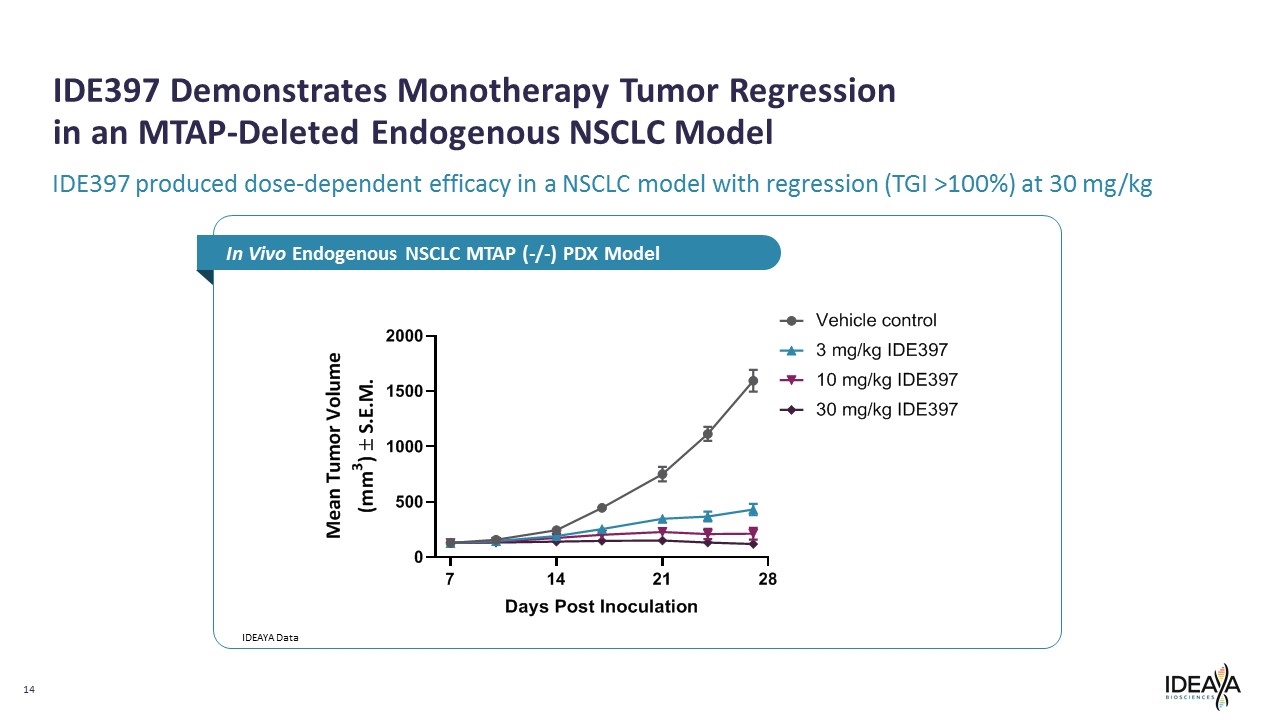
IDE397 produced dose-dependent efficacy in a NSCLC model with regression (TGI >100%) at 30 mg/kg IDE397 Demonstrates Monotherapy Tumor Regression in an MTAP-Deleted Endogenous NSCLC Model In Vivo Endogenous NSCLC MTAP (-/-) PDX Model IDEAYA Data [BAR CHART]
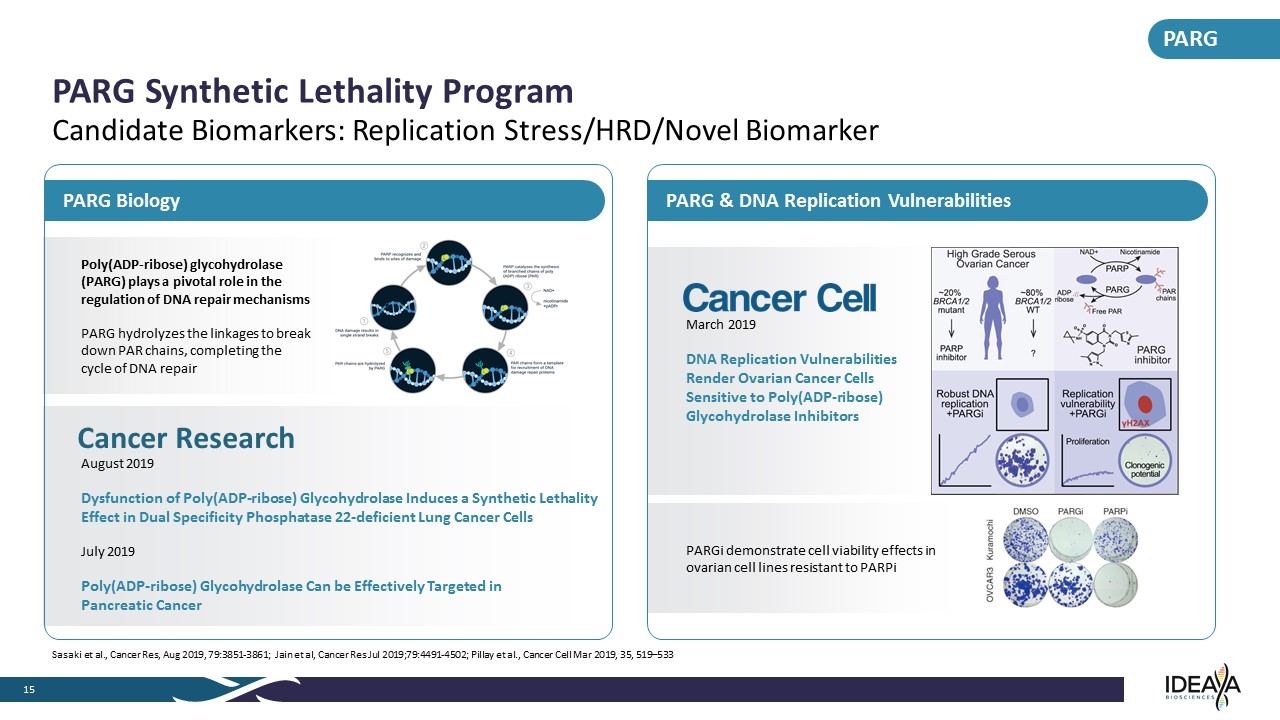
Poly(ADP-ribose) glycohydrolase (PARG) plays a pivotal role in the regulation of DNA repair mechanisms PARG hydrolyzes the linkages to break down PAR chains, completing the cycle of DNA repair August 2019 Dysfunction of Poly(ADP-ribose) Glycohydrolase Induces a Synthetic Lethality Effect in Dual Specificity Phosphatase 22-deficient Lung Cancer Cells July 2019 Poly(ADP-ribose) Glycohydrolase Can be Effectively Targeted in Pancreatic Cancer PARG Synthetic Lethality Program Candidate Biomarkers: Replication Stress/HRD/Novel Biomarker Sasaki et al., Cancer Res, Aug 2019, 79:3851-3861; Jain et al, Cancer Res Jul 2019;79:4491-4502; Pillay et al., Cancer Cell Mar 2019, 35, 519–533 March 2019 DNA Replication Vulnerabilities Render Ovarian Cancer Cells Sensitive to Poly(ADP-ribose) Glycohydrolase Inhibitors PARGi demonstrate cell viability effects in ovarian cell lines resistant to PARPi PARG & DNA Replication Vulnerabilities PARG Biology PARG Cancer Research Parp recognizes and binds to sites of damage parp catalyzes the synthesis of branched chains of poly (adp) ribose (par) nad+ nicotinamide+padpr par chains form a template for recruitment of dna damage repair proteins dna damage results in single strand breaks par chains are hydrolyzed by parg high grade serous ovarian cancer nad+nicotinamide parp parg par chains adp ribose free par parg inhibitor~20%brca1/2 mutant ~80% brca ½ WT ? robust dna replication +pargi replication vulnerability+pargi proliferation clonogenic potential ovcar3 kuramochi dmso pargi parpi
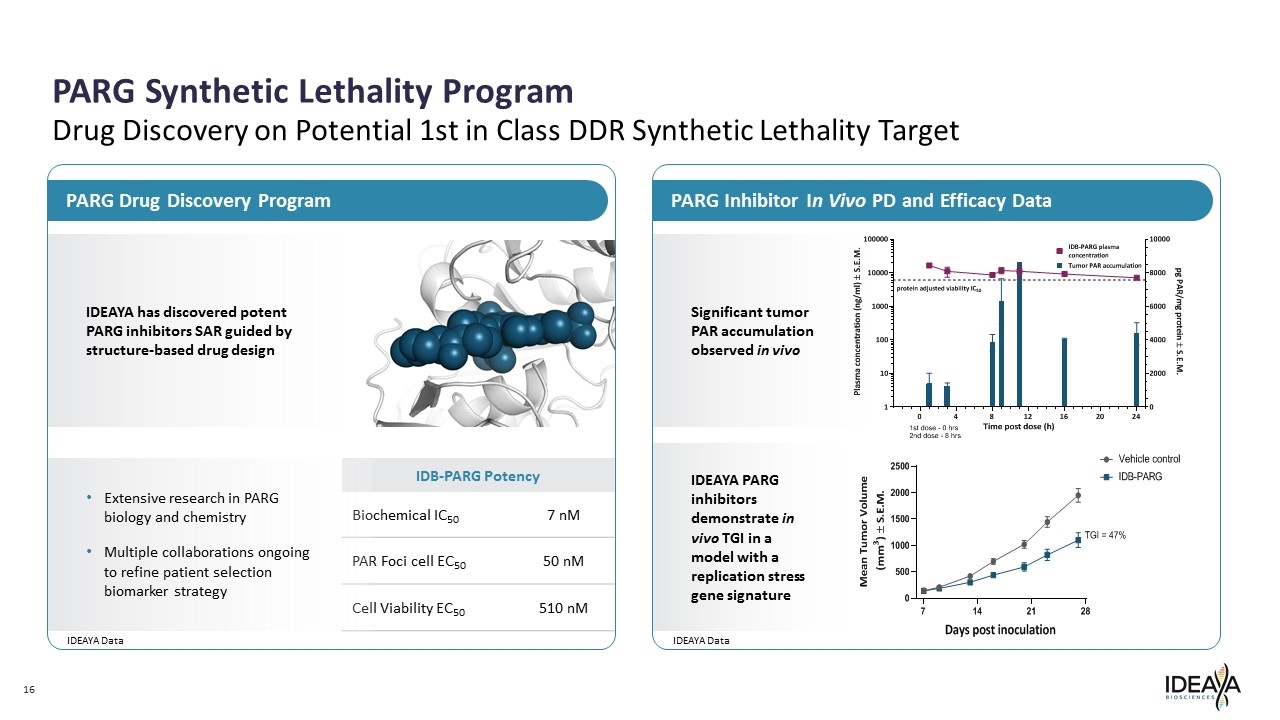
IDB-PARG Potency Biochemical IC50 7 nM PAR Foci cell EC50 50 nM Cell Viability EC50 510 nM Extensive research in PARG biology and chemistry Multiple collaborations ongoing to refine patient selection biomarker strategy IDEAYA has discovered potent PARG inhibitors SAR guided by structure-based drug design PARG Inhibitor In Vivo PD and Efficacy Data PARG Drug Discovery Program PARG Synthetic Lethality Program Drug Discovery on Potential 1st in Class DDR Synthetic Lethality Target IDEAYA PARG inhibitors demonstrate in vivo TGI in a model with a replication stress gene signature Significant tumor PAR accumulation observed in vivo IDEAYA Data IDEAYA Data [logo] [BAR CHART]
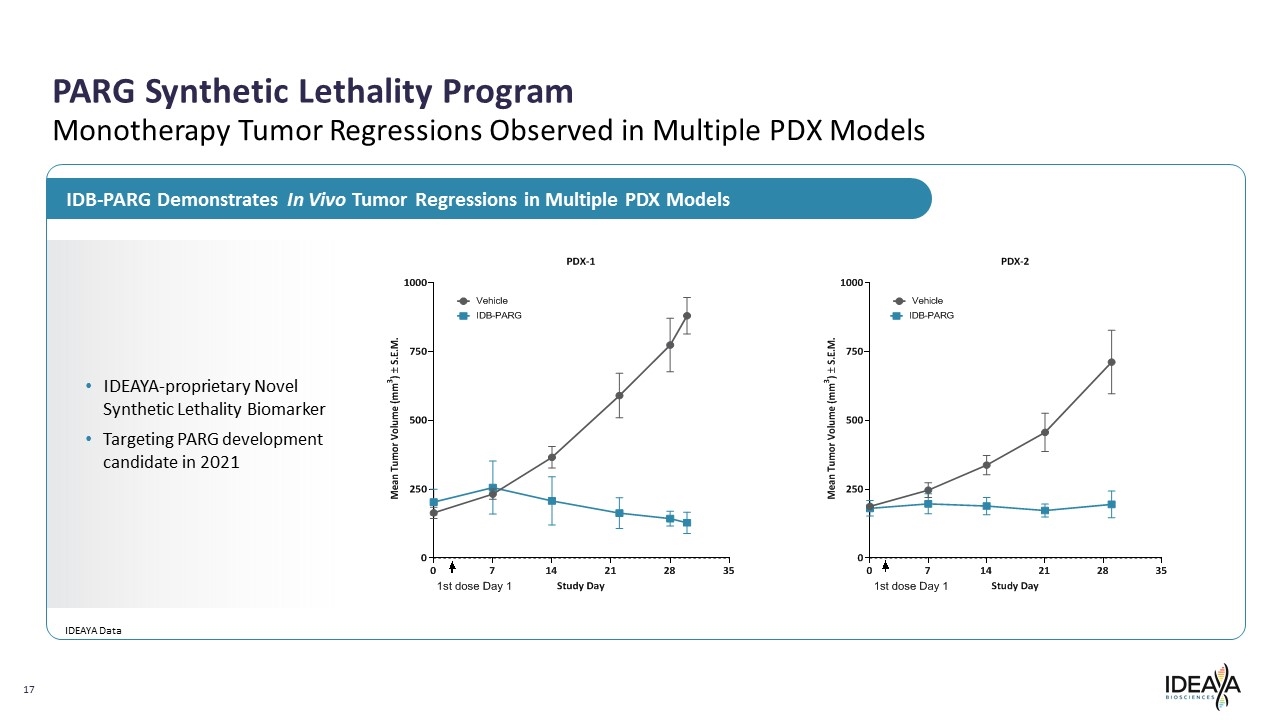
IDEAYA-proprietary Novel Synthetic Lethality Biomarker Targeting PARG development candidate in 2021 PARG Synthetic Lethality Program Monotherapy Tumor Regressions Observed in Multiple PDX Models IDB-PARG Demonstrates In Vivo Tumor Regressions in Multiple PDX Models IDEAYA Data [BAR CHART]
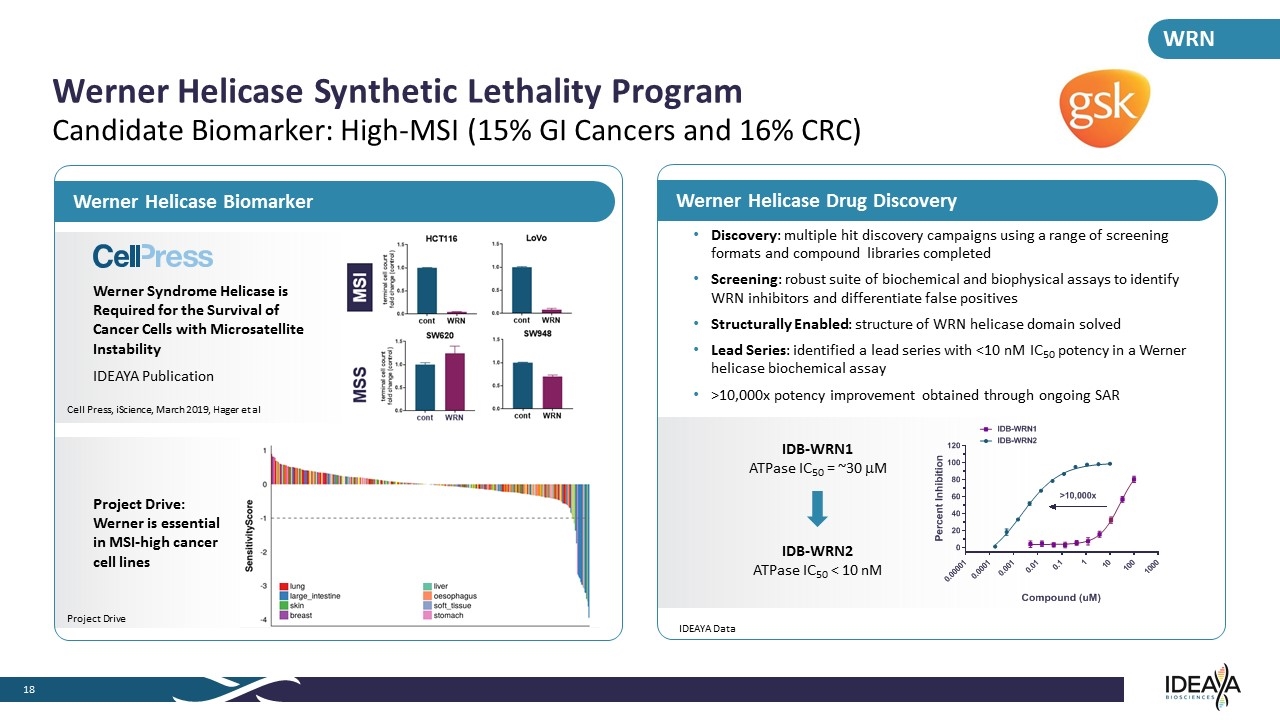
Project Drive: Werner is essential in MSI-high cancer cell lines Werner Syndrome Helicase is Required for the Survival of Cancer Cells with Microsatellite Instability IDEAYA Publication Discovery: multiple hit discovery campaigns using a range of screening formats and compound libraries completed Screening: robust suite of biochemical and biophysical assays to identify WRN inhibitors and differentiate false positives Structurally Enabled: structure of WRN helicase domain solved Lead Series: identified a lead series with <10 nM IC50 potency in a Werner helicase biochemical assay >10,000x potency improvement obtained through ongoing SAR Werner Helicase Drug Discovery Werner Helicase Biomarker WRN Werner Helicase Synthetic Lethality Program Candidate Biomarker: High-MSI (15% GI Cancers and 16% CRC) IDB-WRN1 ATPase IC50 = ~30 mM IDB-WRN2 ATPase IC50 < 10 nM IDEAYA Data Project Drive Cell Press, iScience, March 2019, Hager et al [COMPANY LOGO] [BAR CHART]
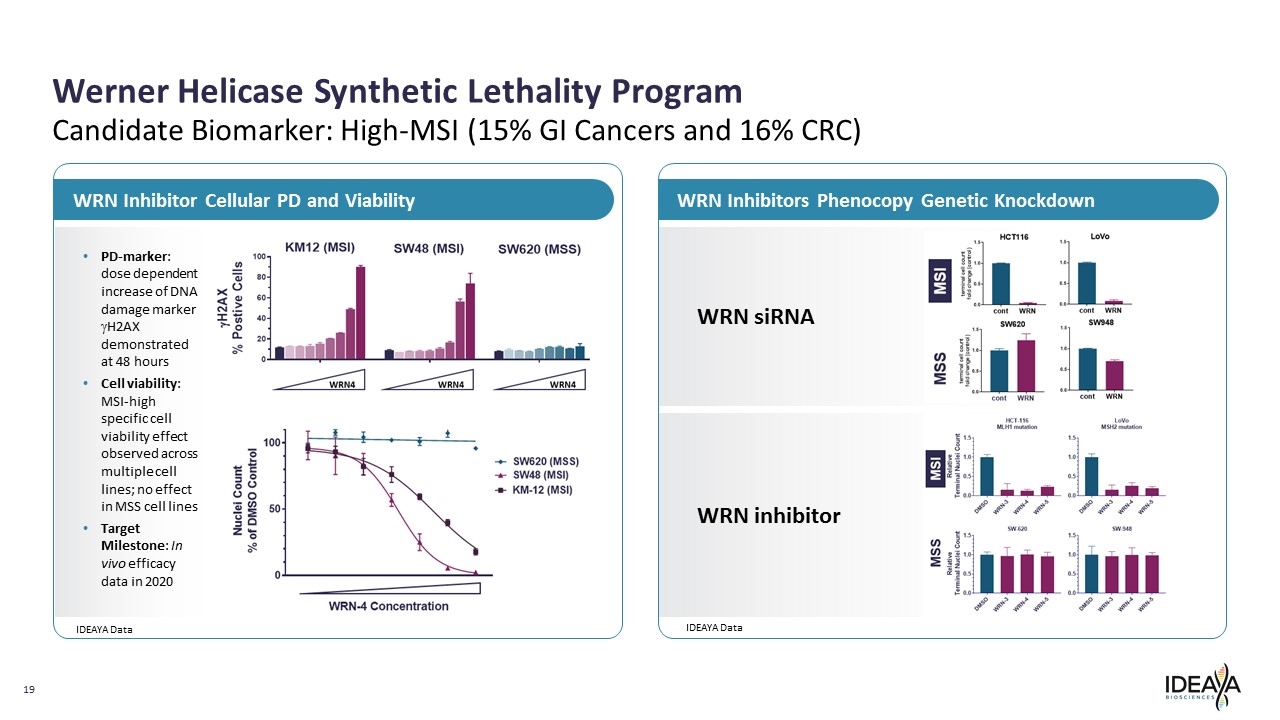
WRN Inhibitors Phenocopy Genetic Knockdown WRN Inhibitor Cellular PD and Viability WRN inhibitor WRN siRNA Werner Helicase Synthetic Lethality Program Candidate Biomarker: High-MSI (15% GI Cancers and 16% CRC) IDEAYA Data PD-marker: dose dependent increase of DNA damage marker gH2AX demonstrated at 48 hours Cell viability: MSI-high specific cell viability effect observed across multiple cell lines; no effect in MSS cell lines Target Milestone: In vivo efficacy data in 2020 IDEAYA Data [BAR CHART]
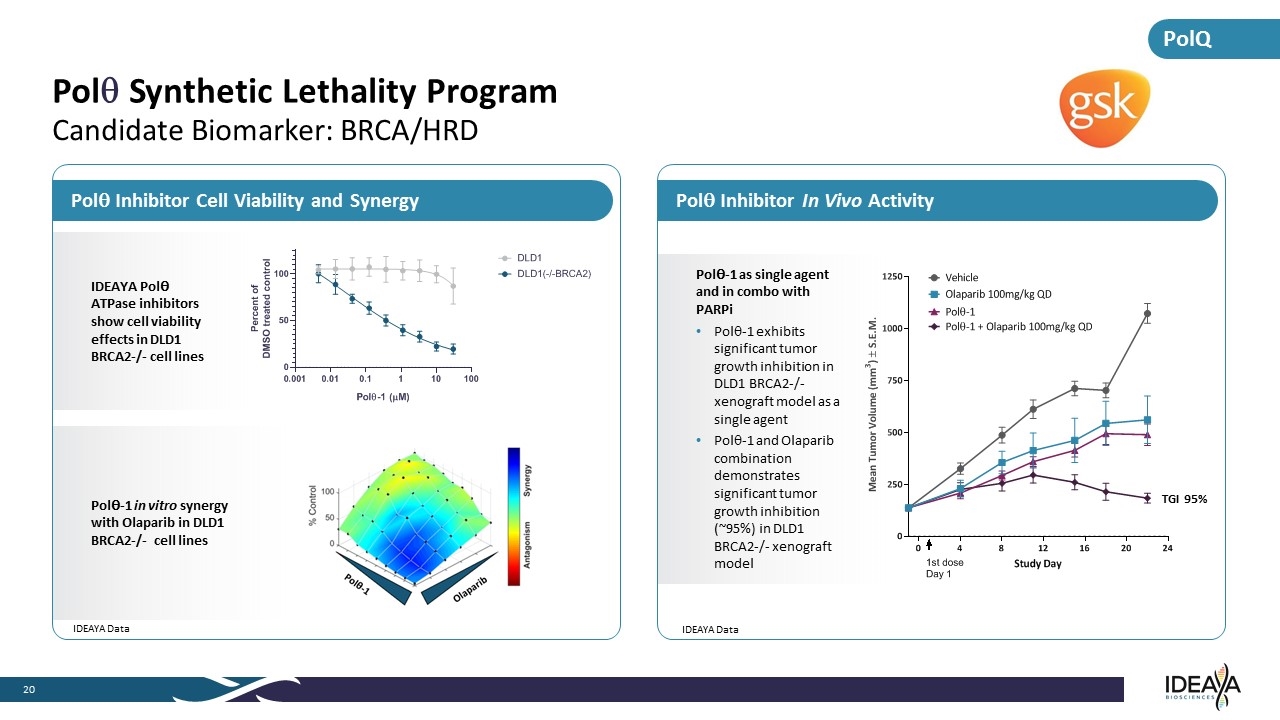
Polq Inhibitor In Vivo Activity Polq Inhibitor Cell Viability and Synergy PolQ Polq-1 as single agent and in combo with PARPi Polq-1 exhibits significant tumor growth inhibition in DLD1 BRCA2-/- xenograft model as a single agent Polq-1 and Olaparib combination demonstrates significant tumor growth inhibition (~95%) in DLD1 BRCA2-/- xenograft model Polq Synthetic Lethality Program Candidate Biomarker: BRCA/HRD TGI 95% IDEAYA Data IDEAYA Polq ATPase inhibitors show cell viability effects in DLD1 BRCA2-/- cell lines Polq-1 in vitro synergy with Olaparib in DLD1 BRCA2-/- cell lines IDEAYA Data [BAR CHART]
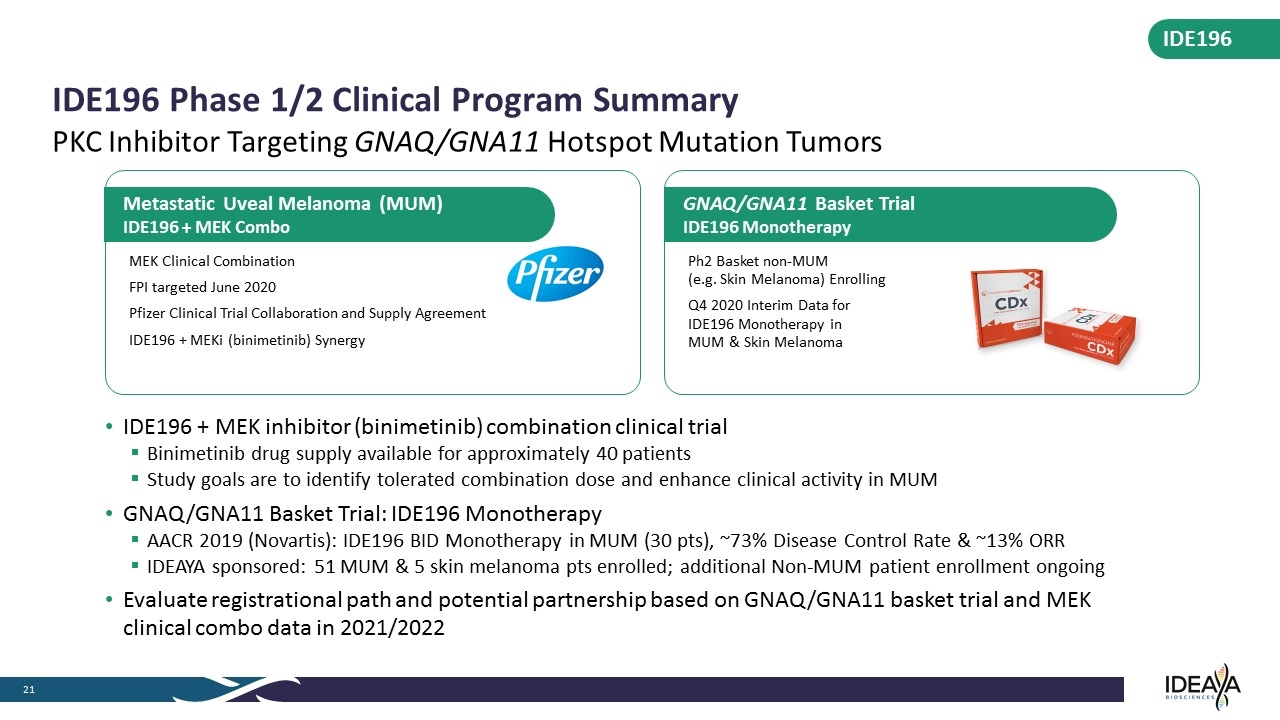
MEK Clinical Combination FPI targeted June 2020 Pfizer Clinical Trial Collaboration and Supply Agreement IDE196 + MEKi (binimetinib) Synergy Metastatic Uveal Melanoma (MUM) IDE196 + MEK Combo IDE196 IDE196 Phase 1/2 Clinical Program Summary IDE196 + MEK inhibitor (binimetinib) combination clinical trial Binimetinib drug supply available for approximately 40 patients Study goals are to identify tolerated combination dose and enhance clinical activity in MUM GNAQ/GNA11 Basket Trial: IDE196 Monotherapy AACR 2019 (Novartis): IDE196 BID Monotherapy in MUM (30 pts), ~73% Disease Control Rate & ~13% ORR IDEAYA sponsored: 51 MUM & 5 skin melanoma pts enrolled; additional Non-MUM patient enrollment ongoing Evaluate registrational path and potential partnership based on GNAQ/GNA11 basket trial and MEK clinical combo data in 2021/2022 PKC Inhibitor Targeting GNAQ/GNA11 Hotspot Mutation Tumors Ph2 Basket non-MUM (e.g. Skin Melanoma) Enrolling Q4 2020 Interim Data for IDE196 Monotherapy in MUM & Skin Melanoma GNAQ/GNA11 Basket Trial IDE196 Monotherapy [COMPANY LOGO]
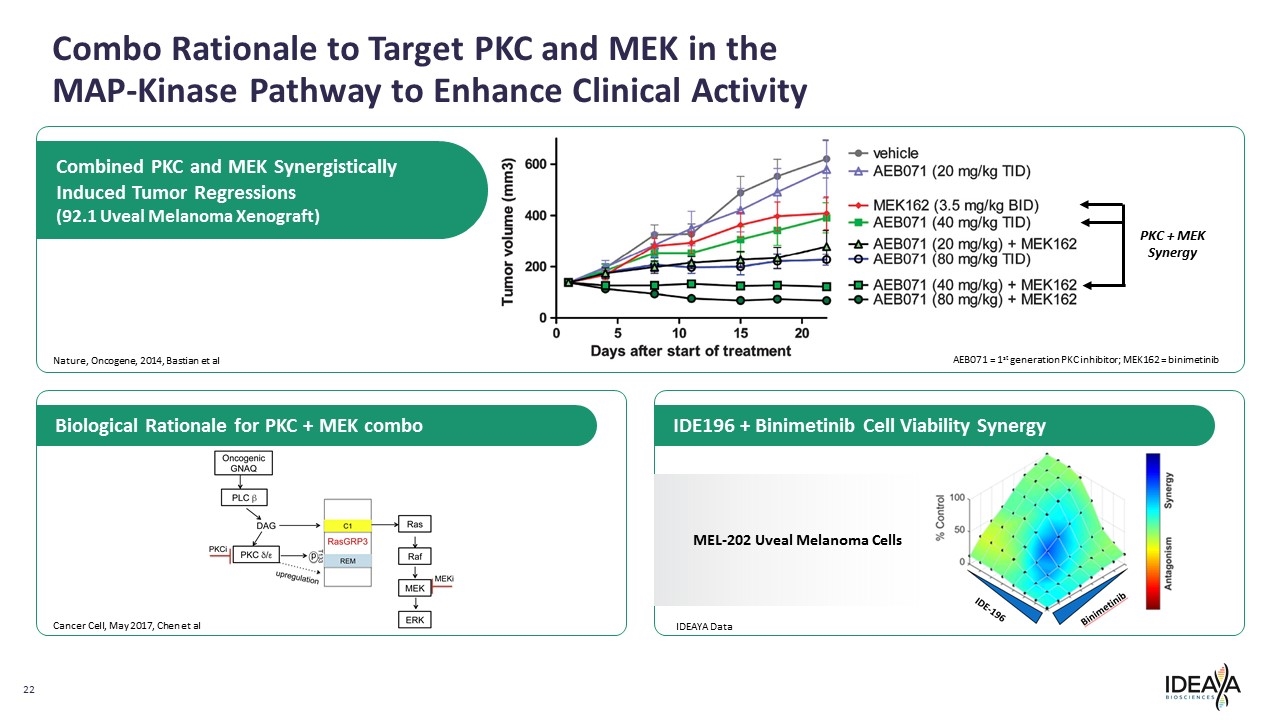
AEB071 = 1st generation PKC inhibitor; MEK162 = binimetinib PKC + MEK Synergy MEL-202 Uveal Melanoma Cells Combo Rationale to Target PKC and MEK in the MAP-Kinase Pathway to Enhance Clinical Activity Combined PKC and MEK Synergistically Induced Tumor Regressions (92.1 Uveal Melanoma Xenograft) Biological Rationale for PKC + MEK combo IDE196 + Binimetinib Cell Viability Synergy IDEAYA Data Cancer Cell, May 2017, Chen et al Nature, Oncogene, 2014, Bastian et al [BAR CHART]
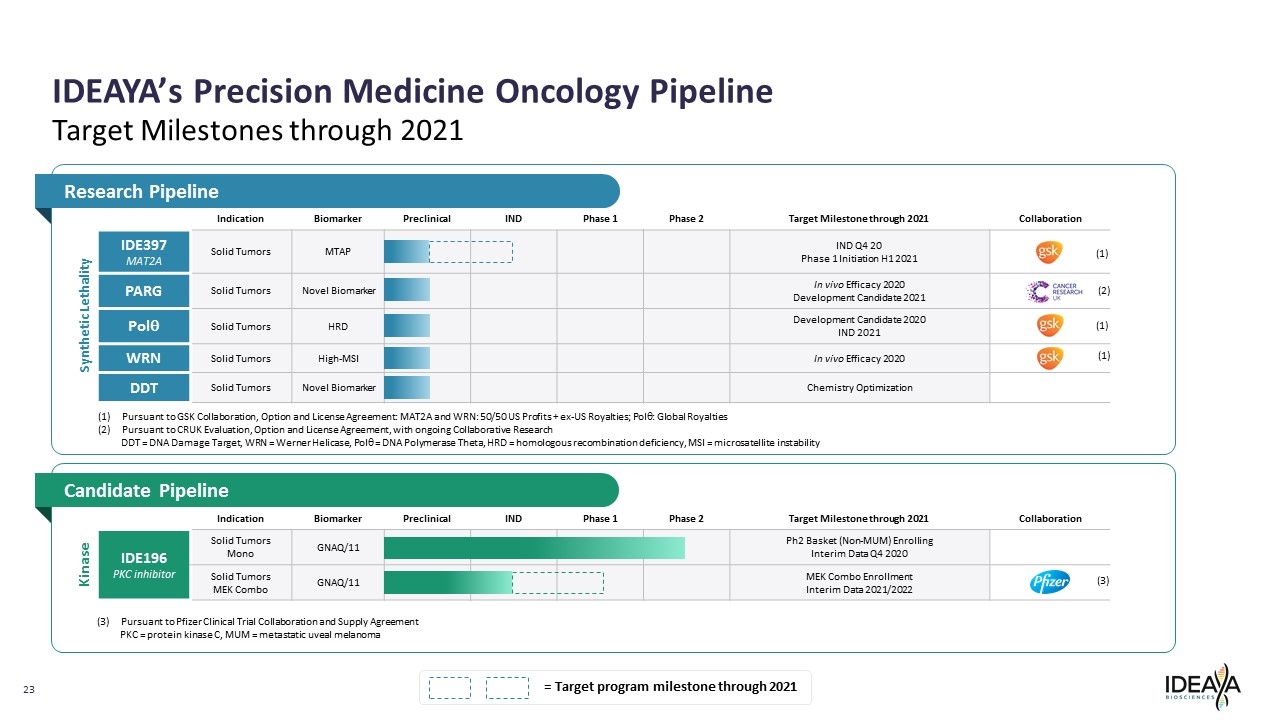
Indication Biomarker Preclinical IND Phase 1 Phase 2 Target Milestone through 2021 Collaboration IDE397 MAT2A Solid Tumors MTAP IND Q4 20 Phase 1 Initiation H1 2021 PARG Solid Tumors Novel Biomarker In vivo Efficacy 2020 Development Candidate 2021 Polq Solid Tumors HRD Development Candidate 2020 IND 2021 WRN Solid Tumors High-MSI In vivo Efficacy 2020 DDT Solid Tumors Novel Biomarker Chemistry Optimization IDEAYA’s Precision Medicine Oncology Pipeline Target Milestones through 2021 Indication Biomarker Preclinical IND Phase 1 Phase 2 Target Milestone through 2021 Collaboration IDE196 PKC inhibitor Solid Tumors Mono GNAQ/11 Ph2 Basket (Non-MUM) Enrolling Interim Data Q4 2020 Solid Tumors MEK Combo GNAQ/11 MEK Combo Enrollment Interim Data 2021/2022 Kinase Candidate Pipeline Research Pipeline Synthetic Lethality = Target program milestone through 2021 (1) (1) (1) (2) (3) Pursuant to GSK Collaboration, Option and License Agreement: MAT2A and WRN: 50/50 US Profits + ex-US Royalties; Polq: Global Royalties Pursuant to CRUK Evaluation, Option and License Agreement, with ongoing Collaborative Research DDT = DNA Damage Target, WRN = Werner Helicase, Polq = DNA Polymerase Theta, HRD = homologous recombination deficiency, MSI = microsatellite instability Pursuant to Pfizer Clinical Trial Collaboration and Supply Agreement PKC = protein kinase C, MUM = metastatic uveal melanoma [COMPANY LOGO]
